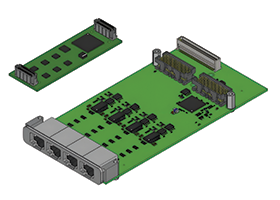

Aerospace and defence system designers are demanding scalable and high-performance I/O solutions. While traditional mezzanine standards have proven reliable, they often fall short of meeting modern bandwidth, size, and flexibility requirements. This challenge is particularly evident in aerospace and defence applications where high-speed data processing must align with stringent size, weight, and power (SWaP) constraints.
Current mezzanine solutions also face significant limitations in scalability, thermal management, and I/O density. These constraints can lead to compromised system performance and limited upgrade paths in applications where adaptability is crucial. The white paper (link at the end of the article) explores how the new VITA 93 (QMC) standard addresses these challenges through its innovative QMC architecture, enabling unprecedented modularity, flexibility, scalability, and rugged reliability while maintaining compatibility with existing and future systems. It also covers how VITA 93 (QMC) builds on lessons learned from previous standards, blending their best features with new capabilities for the future.
VITA 93 (QMC) builds on existing technology while addressing inherent challenges in current mezzanine card standards such as PMC and XMC. These issues include size, compatibility, thermal management, and limited expansion capabilities.
Modern systems demand compact solutions without compromising capabilities. Existing mezzanine cards, like XMC, were not designed to meet these stringent SWaP requirements, posing significant obstacles in aerospace, defence, industrial, medical and transportation sectors.
As Dean Holman, president and executive director of VITA, notes, “The circuit boards used in older PMC and XMC designs are simply too large for today’s compact systems.”
With current mezzanine card standards, system integration can sometimes become difficult: Air-cooled and conduction-cooled XMC cards are based on different designs and provide multiple I/O options. These factors mean that designers must spend extra time and effort ensuring everything will work together and sometimes have fewer options than they would like.
Getting the heat off the cards can also be problematic. As field programmable gate arrays (FPGAs) and application specific integrated circuits (ASICs) become more powerful, they generate substantial heat, which current mezzanine cards often struggle to dissipate efficiently.
Additionally, the increased complexity and requirements of today’s systems leads to the need for system-health monitoring. Current mezzanine standards like XMC come only with a half-hearted approach to Intelligent Platform Management Interfaces (IPMI) and therefore require a higher integration effort.
Lastly, current mezzanine cards lack flexibility for growth as they come in fixed sizes – often too big – that cannot be easily changed, a situation akin to having a drawer that cannot be made bigger or smaller based on what you need to store. Engineers often end up either buying more capability than they need or not having enough space for all requirements.
These challenges call for a new approach – one that is more flexible, can scale with changing needs, and works efficiently across different platforms. This is where VITA 93 (QMC) steps in.
To read the full whitepaper, visit www.dataweek.co.za/ex/VITA93QMC.pdf
| Tel: | +27 21 975 8894 |
| Email: | [email protected] |
| www: | www.ri-tech.co.za |
| Articles: | More information and articles about Rugged Interconnect Technologies |

© Technews Publishing (Pty) Ltd | All Rights Reserved